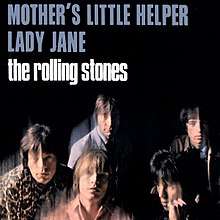Mother's Little Helper
"Mother's Little Helper" is a song by the English rock band the Rolling Stones. It first appeared as the opening track to the United Kingdom version of their 1966 album Aftermath. It was released as a single in the United States and peaked at number eight on the Billboard Hot 100 singles chart in 1966.
| "Mother's Little Helper" | ||||
|---|---|---|---|---|
 | ||||
| Single by the Rolling Stones | ||||
| from the album Aftermath (UK edition) | ||||
| Released |
| |||
| Recorded | December 1965 | |||
| Studio | RCA, Hollywood, California | |||
| Genre | Folk rock[1] | |||
| Length | 2:40 | |||
| Label |
| |||
| Songwriter(s) | Jagger/Richards | |||
| Producer(s) | Andrew Loog Oldham | |||
| The Rolling Stones US singles chronology | ||||
| ||||
| Aftermath track listing | ||||
14 tracks
| ||||
The song deals with the sudden popularity of prescribed calming drugs among housewives, and the potential hazards of overdose or addiction. The drug in question is variously assumed to be meprobamate (Miltown)[2] or diazepam (Valium).[3]
Writing and recording
Written by Mick Jagger and Keith Richards, "Mother's Little Helper" was recorded at the RCA Records studios in Hollywood, California, in March 1966.[4] According to the music historian Nicholas Schaffner, Jagger demonstrates "his crudest irony" on "Aftermath's most overt 'drug song'" … at a time when the adult media were beginning to rant about teenage drug abuse". Schaffner goes on to say "the Stones retaliated by zeroing in on all those harried middle-aged housewives incapable of getting through the day, or getting to sleep at night, without the help of their legally prescribed 'little yellow pills.'"[5]
The song begins with the line that is also heard as the last line in the repeated bridge section:
What a drag it is getting old
Kids are different today, I hear every mother say
Mother needs something today to calm her down
And though she's not really ill, there's a little yellow pill
She goes running for the shelter of a mother's little helper
And it helps her on her way, gets her through her busy day[6]
Toward the end of the song, the mothers are warned:
And if you take more of those, you will get an overdose
No more running for the shelter of a mother's little helper
They just helped you on your way, to your busy dying day[6]
The song is based around folksy chords and an eastern-flavoured guitar riff sounding like a sitar, but is a dual-slide riff played on two electric 12-string guitars by Brian Jones and Keith Richards.[7] Keith Richards has noted that the ending of the song was the idea of Bill Wyman, who also contributed a powerful and distinctive bass riff.[8]
Reception and legacy
"Mother's Little Helper" peaked at number eight on the Billboard Hot 100 chart in 1966. The single's B-side, "Lady Jane", reached number 24.[9]
Of the song's mainstream impact, John Mendelsohn of PopMatters writes that, "In pointing out the hypocrisy of a culture that tut-tuts rockers for recreational drug use while actively endorsing and prescribing mind-altering drugs to housewives, the Rolling Stones effectively cemented their reputation as a subversive cultural force."[10]
In 2005, American singer-songwriter Liz Phair covered "Mother's Little Helper" for the soundtrack album Music from and Inspired by Desperate Housewives.
Personnel
- Mick Jagger – lead vocals, percussion
- Keith Richards – electric twelve-string-slide guitar, acoustic guitar, backing vocals
- Brian Jones – electric twelve-string-slide guitar, acoustic guitar
- Bill Wyman – bass guitar
- Charlie Watts – drums
- Jack Nitzsche – Nitzsche-Phone
Charts
| Chart (1966) | Peak position |
|---|---|
| Canada Top Singles (RPM)[11] | 14 |
| Germany (Official German Charts)[12] | 9 |
| US Billboard Hot 100[13] | 8 |
References
- Luhrssen, David; Larson, Michael (2017). Encyclopedia of Classic Rock. ABC-CLIO. p. 305. ISBN 9781440835148.
- Esther Inglis-Arkell. "This Is The Drug In The Rolling Stones' Song "Mother's Little Helper"". Io9.gizmodo.com. Retrieved 2016-09-29.
- U.S. News and World Report, Vol. 127, p. 58 (1999): “A song on the 1967 Rolling Stones album Flowers was entitled ‘Mother's Little Helper,’ a tongue-in-cheek ode to a housewife coping with bratty kids and a demanding husband, thanks to Valium....”
- Eder, Bruce (1989). Singles Collection: The London Years (Boxed set booklet). The Rolling Stones. New York City: ABKCO Records. p. 71. 1218-2.CS1 maint: ref=harv (link)
- Schaffner, Nicholas (1982). The British Invasion: From the First Wave to the New Wave. McGraw-Hill. p. 69. ISBN 0070550891.CS1 maint: ref=harv (link)
- Gilliland, John (1969). "The Rubberization of Soul: The great pop music renaissance" (audio). Pop Chronicles. University of North Texas Libraries. Track 5.
- Guesdon, Margotin, Jean-Michel, Philippe (2016). The Rolling Stones All the Songs: The Story Behind Every Track. Black Dog & Leventhal Publishers Inc. ISBN 0316317748.
- Ian McPherson. "Mother's Little Helper". Timeisonourside.com. Retrieved 2016-09-29.
- Joel Whitburn (1985), The Billboard Book of Top 40 Hits, ISBN 0-8230-7518-4
- Mendelsohn, Jason; Klinger, Eric (19 April 2013). "Counterbalance No. 125: The Rolling Stones' 'Aftermath'". PopMatters. Retrieved 28 March 2020.
- "Top RPM Singles: Issue 5789." RPM. Library and Archives Canada. Retrieved 17 June 2016.
- "Offiziellecharts.de – The Rolling Stones – Mother's Little Helper". GfK Entertainment Charts. Retrieved 17 June 2016.
- "The Rolling Stones Chart History (Hot 100)". Billboard. Retrieved 17 June 2016.